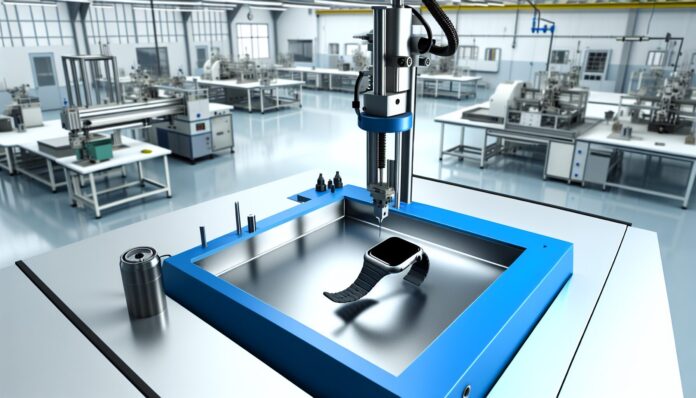Apple has officially confirmed that it is using 3D printing technology in the production of the Apple Watch, marking a significant step forward in the company’s manufacturing strategy. This revelation, shared during a recent interview with Apple’s VP of Operations, sheds light on how additive manufacturing is helping Apple streamline production, reduce waste, and potentially reshape the future of hardware design.
Apple Embraces 3D Printing for Apple Watch Components
In a recent interview with Popular Mechanics, Apple’s Vice President of Operations, Rob Guzzo, revealed that the company is using 3D printing to manufacture components of the Apple Watch. Specifically, Apple is employing a technique known as binder jetting to produce the stainless steel chassis of certain Apple Watch models.
Binder jetting is an additive manufacturing process where a binding agent is selectively deposited onto a powder bed—typically metal powder—to build up a part layer by layer. Once printed, the part is sintered in a furnace to fuse the particles into a solid metal component. This method allows Apple to create complex geometries with less material waste compared to traditional subtractive manufacturing methods like CNC machining.
Why Apple Turned to Additive Manufacturing
Apple’s decision to integrate 3D printing into its production line is driven by several key factors. First, the company is constantly seeking ways to improve efficiency and reduce its environmental footprint. Traditional manufacturing methods often involve cutting away large amounts of material, which can be both wasteful and energy-intensive. In contrast, 3D printing builds parts additively, using only the material necessary for the final product.
Guzzo explained that the binder jetting process not only reduces waste but also shortens the time it takes to go from design to finished part. This agility allows Apple’s design and engineering teams to iterate more quickly and bring new products to market faster. Additionally, the ability to produce parts with complex internal structures opens up new possibilities for product design and performance.
Testing the Waters: Apple Watch as a Pilot Program
Apple began testing 3D printing for the Apple Watch in 2023, starting with select stainless steel models. The company used this as a pilot program to evaluate the feasibility of scaling additive manufacturing for mass production. According to Guzzo, the results have been promising, and Apple is now exploring how to expand the use of 3D printing to other product lines.
“We’ve been working on this for years,” Guzzo said. “We wanted to make sure the quality and performance met our standards before rolling it out more broadly.”
Apple’s cautious but deliberate approach reflects its commitment to maintaining the high standards of fit and finish that its products are known for. By starting with a relatively small and high-end product like the Apple Watch, Apple can refine its processes before applying them to larger-scale devices like iPhones or MacBooks.
The Future of 3D Printing in Consumer Electronics
Apple’s adoption of 3D printing is part of a broader trend in the consumer electronics industry. As additive manufacturing technologies mature, more companies are exploring how they can be used to improve product design, reduce costs, and enhance sustainability.
For Apple, the move aligns with its broader environmental goals. The company has pledged to become carbon neutral across its entire supply chain by 2030, and reducing material waste through 3D printing is one way to help achieve that target.
Moreover, the flexibility of 3D printing could enable Apple to offer more customization options in the future. Imagine a world where customers can choose from a wider range of materials, finishes, or even personalized engravings—all made possible by additive manufacturing.
Technical Details: How Binder Jetting Works
Binder jetting, the process Apple is using, is particularly well-suited for producing metal parts at scale. Unlike other metal 3D printing methods such as selective laser melting (SLM) or direct metal laser sintering (DMLS), binder jetting does not require high-powered lasers or complex support structures. This makes it faster and more cost-effective for certain applications.
Here’s a simplified breakdown of the process:
- A thin layer of metal powder is spread across a build platform.
- A print head deposits a liquid binding agent onto the powder, solidifying the desired areas.
- This process repeats layer by layer until the part is complete.
- The printed part, known as a “green part,” is then removed and sintered in a furnace to fuse the metal particles.
The result is a fully dense metal component with mechanical properties comparable to those made using traditional methods.
Implications for the Industry
Apple’s use of 3D printing could have ripple effects across the tech industry. As one of the world’s most influential hardware manufacturers, Apple’s endorsement of additive manufacturing may encourage other companies to explore similar technologies. It also signals to suppliers and contract manufacturers that 3D printing is becoming a viable option for high-volume production.
Furthermore, Apple’s investment in this space could drive innovation in 3D printing hardware, materials, and software. As the company pushes the limits of what’s possible, it may help accelerate the development of next-generation additive manufacturing solutions.
In summary, Apple’s confirmation that it is using 3D printing to produce Apple Watch components marks a significant milestone in the evolution of consumer electronics manufacturing. By leveraging binder jetting technology, Apple is not only improving efficiency and sustainability but also laying the groundwork for a more flexible and innovative future.
Source: 9to5Mac

